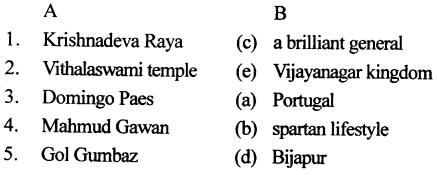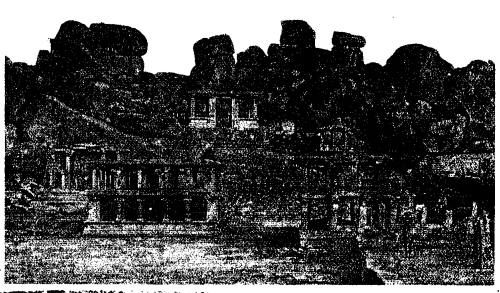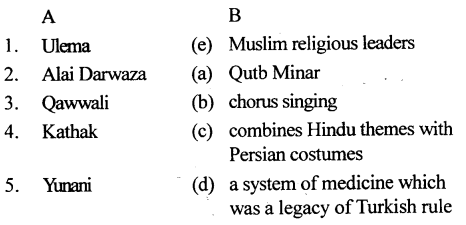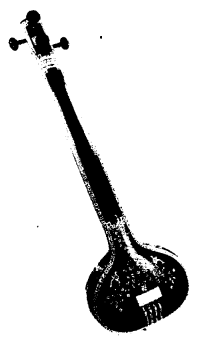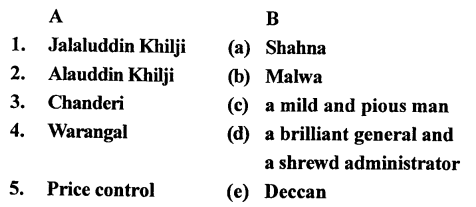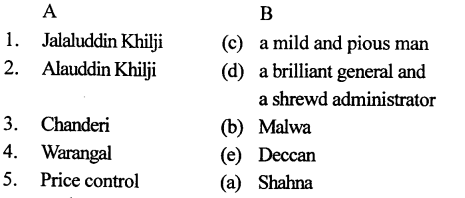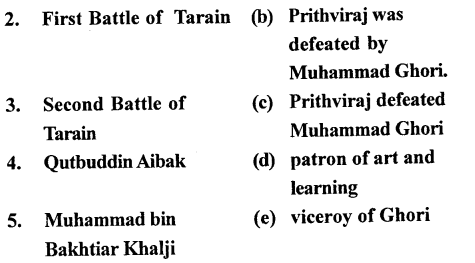The Trail History and Civics for Class 7 ICSE Solutions – Babur, Humayun and Sher Shah
ICSE SolutionsSelina ICSE SolutionsML Aggarwal Solutions
Trail HistoryCivics Focus on HistoryCivicsGeographyMathsPhysicsChemistryBiology
EXERCISE
A. Fill in the blanks :
- Babur lost both Farghana and Samarkand and became a homeless wanderer. In 1504 CE, he became the ruler of Kabul.
- Humayun lacked the qualities necessary to consolidate the vast empire he had inherited.
- Sher Shah based his administration on the principle of a welfare state.
- Sher Shah went on regular tours of inspection and set up an efficient spy system.
- Sher Shah established a large standing army and introduced several reforms to make it disciplined, efficient and strong.
B. Match the following :


Answer:
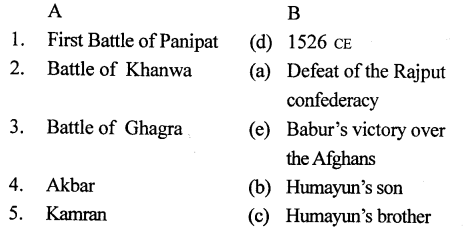
C. Choose the correct answer:
1. In 1522 CE, Ibrahim Lodi/Sher Khan Suri/Daulat Khan Lodi invited Babur to invade India.
Ans. In 1522 CE, Daulat Khan Lodi invited Babur to invade India
2. With the help of the Shah of Persia/Afghanistan/Sind, Humayun returned to India in the year 1555 CE.
Ans. With the help of the Shah of Persia, Humayun returned to India in the year 1555 CE.
3. Sher Shah divided his empire into 47 sarkars/parganas/ villages.
Ans. Sher Shah divided his empire into 47 sarkars.
4. The rupia introduced by Sher Shah was made of goldV silver/copper.
Ans. The rupia introduced by Sher Shah was made of silver.
5. Sher Shah’s greatest achievement was the construction of new roads/issuing of coins/his revenue system.
Ans. Sher Shah’s greatest achievement was his revenue system.
D. State whether the following are true or false :
1. Babur was a descendant of Timur and Chenghiz Khan.
Ans. True.
2. Babur’s war-weary and homesick soldiers wanted to return to Kabul after the Battle of Panipat.
Ans. True.
3. Babur won the Battle of Khanwa through treachery and cunning.
Ans. False.
Correct : Babur won the Battle of Khanwa with his superior artillery and covering.
4. Sher Shah ruled for 15 years.
Ans. False.
Correct : Sher Shah ruled for 5 years.
5. To prevent the officers from becoming corrupt, Sher Shah introduced the system of periodical transfers.
Ans. True.
E. Answer the following questions in one or two words/ sentences :
Question 1.
Why did Daulat Khan Lodi invite Babur to invade India?
Answer:
In 1522 CE, Daulat Khan Lodi invited Babur to invade India and help him overthrow Ibrahim Lodi, the cruel and unpopular sultan of Delhi.
Question 2.
Between whom was the First Battle of Panipat fought?
Answer:
Babur and Ibrahim Lodi came face-to-face at Panipat in 1526 CE.
Question 3.
What was the significance of the Battle of Panipat (1526 CE)?
Answer:
After the First Battle of Panipat Delhi came under the rule of Babur and he was declared the emperor of Hindustan.
Question 4.
What is the name of Babur’s autobiography?
Answer:
Tuzuk-i-Baburi it is written in flawless Turkish, and considered to be one of the best autobiographies in the world.
Question 5.
Who was Humayun’s most dangerous enemy?
Answer:
Sher Khan was Humayun’s most dangerous enemy.
Question 6.
How did Humayun escape after his deafeat in the Battle of Chausa (1539 CE)?
Answer:
Humayun jumped into the Ganga and floated down the river with the help of a water carrier’s inflated water bag.
Question 7.
How many years did Humayun spend in exile?
Answer:
15 years (1540-55 CE), Humayun wandered about from place to place in search of shelter.
Question 8.
Who helped Humayan to recover Kabul and Kandahar?
Answer:
Shah of Persia helped Humayun and he recovered Kabul and Kandahar from his brother Kamran.
Question 9.
What is the significance of the Battle of Kanauj (1540 CE)?
Answer:
The large but fragile Mughal empire came to an end and was replaced by Afghan rule.
Question 10.
How were the affairs of the villages managed during Sher Shah’s reign?
Answer:
The villages were looked after by the panchayats composed of village elders. Sher Shah himself kept in touch with the villages through village officials like patwaris and muqaddam.
Question 11.
Explain the Chehra system in Sher Shah’s military administration.
Answer:
Sher Shah adopted a system of branding horses (dagh) and maintaining a descriptive roll of the soldiers (chehra) were revived. The army was divided into many units and each unit was placed under a commander.
Question 12.
Mention one reason why Sher Shah built an excellent network of good roads?
Answer:
Sher Shah built an excellent network of good roads, to facilitate the quick movement of officials and troops throughout the empire and to promote trade and commerce and even to make travelling comfortable and easier.
F. Answer the following questions briefly :
Question 1.
Give a brief account of Babur’s early life.
Answer:
Babur lost his father, when he was eleven years old and at that tender age he became the ruler of a small principality in Central Asia called Farghana which he inherited from his father. He was also able to fulfill his dream of conquering Samarkand, when he was just 14 years old. But within a short time he lost both Farghana and Samarkand and became homeless but due to his courage and determination, after some time he became the ruler of Kabul.
Question 2.
Give an account of the causes, events and consequences of the First Battle of Panipat.
Answer:
Babur and Ibrahim Lodi came face-to-face at Panipat in 1526 CE. Ibrahim’s large army was no match for Babur’s small, disciplined and loyal army with its excellent cavalry and fine artillery.
Babur was a born leader and an experienced military general. Within a few hours, Ibrahim’s army was routed. By evening, Ibrahim and 15,000 of his soldiers lay dead on the battlefield. The following day, Babur triumphantly entered Delhi where he was proclaimed the emperor of Hindustan.
Question 3.
How many battles did Babur have to fight after the Battle of Panipat? Mention the significance of his victory in each of these battles.
Answer:
After the Battle of Panipat Babur fought three more battles. The significance of each battle are :
(a) Battle of Khanua : This battle was fought between Babur and Rana Sangha of Mewar at Khanua. Babur won this battle and this victory gave him supreme control over central India and it also removed all the obstacles in the way of Mughal rule.
(b) Battle of Chanderi : This battle was fought between Babur and Medini Rai of Malwa. Babur won the battle and captured Chanderi. After this battle, no other Rajput chief ever dared to challenge Babur’s authority.
(c) Battle of Ghagra : The Afghans had control over Bihar and Bengal and they posed a threat to Babur’s authority. So Babur had a war with them and after crushing them he became the master of Punjab, Delhi and the Ganga plains near Bihar.
Question 4.
Give a brief account of Sher Shah’s early life.
Answer:
Sher Shah was the son of Hasan Khan, ajagirdar of Sasaram in Bihar. His real name was Farid Khan. He was given the name Sher Khan after he single-handedly killed a tiger. He joined the Mughal army when Babur invaded India and learnt the techniques of Mughal warfare.
Question 5.
With reference to Sher Shah’s enlightened rule, explain :
(a) How was the central government organized?
(b) The important features of provincial administration.
Answer:
(a) The supreme head of the central government was Sher Shah himself. He divided the government into several departments. Each department was under the charge of a minister, who was assisted by other officials.
(b) The whole empire was divided into forty seven provinces or sarkars. Each province was further subdivided into districts or parganas. Each paragana was made up of a number of villages. The villages were looked after by the panchayats composed of village elders.
Each Sarkar was placed under an Afghan chief. In every pargana there were several officials who were supervised by Shiqdar and Munsif. The Shiqdar was responsible for law, order and general administration and the Munsif looked after the collection of revenue and civil cases.
Question 6.
Sher Shah introduced several measures to make the army disciplined, efficient and strong. Explain?
Answer:
Sher Shah introduced many reforms to make his army efficient, disciplined and strong. He used to take personal interest in the appointment and training of soldiers. The salaries of the soldiers and the officers were fixed according to their skill and ability. The army was divided into many units and each unit was placed under a commander. The cavalry and infantry were highly trained, disciplined and were equipped with artillery.
Question 7.
Discuss the important measures taken by Sher Shah to boost the growth of trade and commerce.
Answer:
The growth of trade and commerce increased after the construction of roads and sarais. Sher Shah even abolished all duties, except two to boost it further more. He even instructed his officials to treat the merchants well and look after their interests. Proper safety was provided to traders and the village headmen was responsible for it in their respective regions. New weights and measures were introduced. Coins of gold, silver and copper of uniform standard were introduced.
Question 8.
What steps did Sher Shah take to maintain law and order in his kingdom?
Answer:
Sher Shah strongly believed injustice and he treated all the people equally. In his kingdom the criminal law was harsh and punishments were severe. The village headmen and the local chieftains were made responsible for any crime that took place in their area. They were severely punished if they failed to track down a robber or a murderer.
Question 9.
Sher Shah’s greatest achievement was his land revenue system. In this context explain :
(a) Land assessments
(b) Taxation policy and its impact
Answer:
(a) Land assessments : Sher Shah made proper arrangements that the land should be carefully surveyed and measured every year and the average produce to be calculated on the basis of its fertility.
(b) Taxation policy and its impact : One – third of the produce was paid as tax in cash or kind. The land was divided into three types – good, bad and medium on the basis of fertility and taxes were levied on this basis.
Question 10.
Sher Shah is one of the most striking personalities in medieval India. In this context, briefly state the important achievements of his 5-years reign.
Answer:
During his reign Sher Shah established a vast, powerful and prosperous empire. Some of his achievements are listed below :
- In his empire there was a powerful central government and a sound administrative system.
- He created a huge standing army that was disciplined, well organized and strong.
- His revenue system was efficient progressive and humane and he also showed concern for the welfare of the peasants.
- During his reign good roads and rest houses were constructed for travellers and merchants.
- New weights and measures were introduced by him.
- He also followed a policy of religious tolerance and appointed many Hindus to high posts of trust.
G Picture study :
This is a picture of the tomb of the successor of Babur Picture Given Below
Question 1.
Name the Mughal emperor who is buried in this tomb.
Answer:
Humayun.
Question 2.
Where is this monument located?
Answer:
Nizamuddin Delhi

Question 3.
In which book could you find a detailed account of his life? Who wrote it?
Answer:
Humayunnama. Gulbadan wrote it.
Question 4.
Why did he spend 15 years in exile?
Answer:
After defeat from Sher Khan . Humayun wandered about 15 years from place to place in search of shelter. His brother refused to help him. In 1542 CE, in a small town in Amarkot in Sind, a son, Akbar was born to Humayun and his wife, Hamida Banu.
Question 5.
How did he reconquer his lost empire?
Answer:
With military help from the Shah of Persia, Humayun returned and recovered Kabul and Kandahar from his brother Kamran. Kamran was blinded and sent to Mecca. By 1554 CE, Humayun had consolidated his position in Afghanistan. Sher Shah had died in 1545 CE. His successors were weak and incompetent. Taking advantage of the situation, Humayun returned to India and recaptured Delhi and Agra in 1555 CE. Humayun died shortly afterwards in an accidental fall down the stairs of his library.
OTHER IMPORTANT QUESTIONS
Question 1.
Describe the political conditions in India on the eve of Babur’s invasion.
Answer:
On the eve of Babur’s invasion India was divided into many small kingdoms ruled by independent kings. The Delhi Sultanate was reduced in size and power. The political seen was disunity among each other.
Question 2.
What information do we get from Babur’s memoirs about :
(a) Babur
(b) Babur’s countrymen
(c) Hindustan
Answer:
(a) Babur : This autobiography gives detail description of Babur. It shows him as a keen observer and provides a picture of his personality. It tells his achievements, adventures, habits and hobbies.
(b) Babur’s countrymen : In this book Babur had given full description of personality, habits, adventures, customs, appearances, manners and occupations of his countrymen.
(c) Hindustan : Babur had given description of boundaries, population, resources, revenues etc. of Hindustan in this book which is quite accurate account. He had also beautifully described about fruits, flowers, birds and animals found here.
Question 3.
Humayun was surrounded by dangerous enemies on all sides. Name any three.
Answer:
The three enemies by which Humayun was surrounded are :
(a) Afghan Chiefs : Many Afghan chiefs were rebellious and the most dangerous in them was Sher Shah, who had an eye on the throne of Delhi.
(b) Bahadur Shah of Gujarat and Malwa : He was also a powerful ruler and he wanted to become the emperor of Delhi.
(c) Brother Kamran : Babur’s brother Kamran was openly hostile and he constantly plotted against him.
Question 4.
When and how did Humayun lose his empire? When did he return and recapture his lost kingdom?
Answer:
Humayun lost his empire after a defeat in the Battle of Kanauj in AD 1540. He was so badly defeated in this war that he went into Exile. With the military help from the Shah of Persia in AD 1554. Humayun was able to capture his kingdom.
Question 5.
Humayun lost his empire because of inherent flaws in his character. Explain.
Answer:
Humayun was a pleasure loving ruler and he lacked political wisdom, military foresight and was not able to take quick and wise decisions. He could not understand the jealousy of his brothers and was not able to take a firm decision on them. He was a capable soldier but a poor general. These all characteristics led to the downfall of Mughal empire.
Question 6.
Give reasons to show Babur was a religious tolerant ruler?
Answer:
Babur was an orthodox Sunni Muslim but he was not a fanatic. He did not allow the Ulemas to influence his decisions and he followed a policy of religious tolerance towards people of other faiths.
Question 7.
When did Humayun ascend the throne and describe the length of boundaries of the kingdom?
Answer:
Humayun ascended the throne in AD 1530. He succeeded a vast empire which extended from Kabul in the west to Bihar in the east and from the Himalayas in the north to Gwalior in the South.
Question 8.
What is Humayunnama?
Answer:
Humayunnama is a book written by Humayun’s sister Gulbadan. It gives a detailed account of Humayun’s life.
Question 9.
Mention three important objectives of Sher Shah’s wise and enlightened rule.
Answer:
Important objectives of Sher Shah’s rule :
- The most important objective was to drive out the Mughals from India and re-establish the Afghan rule in which he was successful.
- He wanted to built an excellent network of communication and for this he built roads to facilitate the quick movement of officials and troops and to promote trade.
- He wanted to improve the Revenue system and for this he brought many reforms like reducing the taxes, providing loans if the crops are damaged and improving the conditions of the peasants.
Question 10.
Describe briefly the main features of Sher Shah’s communication system?
Answer:
Sher Shah built an excellent network of roads to improve the communication system. He built four major roads among which the Grand Trunk road was the longest and the most important. It connected Sonargaon in the east to Peshawar in the north-west. Shady trees were planted on both sides of the roads and rest houses and wells were built for travellers and merchants.
Question 11.
On which principle administration of Sher Shah was based?
Answer:
Sher Shah was a brilliant organizer, both in military and civil affairs. He based his administration on the principle of a welfare state and introduced many reforms.
Question 12.
Describe the features of ‘The Grand Trunk Road’ build by Sher Shah during his reign?
Answer:
The Grand Trunk Road, built by Sher Shah was the longest and the most important of the four roads that he built. It connected Sonargaon in the east to Peshwar in the north west. Shady trees were planted on both sides of the road and rest houses and wells were built at regular intervals for travellers and merchants,
Question 13.
What was the duty of Shiqdar and Munsif?
Answer:
The Shiqdar was responsible for law, order and general administration and the Munsif looked after the collection of revenue and civil cases.
Question 14.
What did Sher Shah do to stop the officials from / becoming corrupt or powerful?
Answer:
To stop the officials from becoming corrupt or powerful, Sher Shah introduced the practice of transferring them periodically and he even looked into every detail of administration himself.

